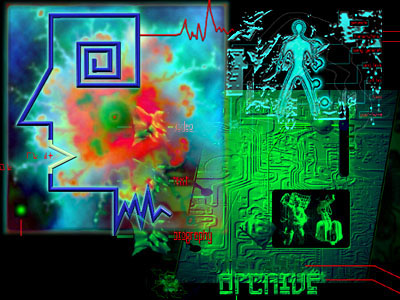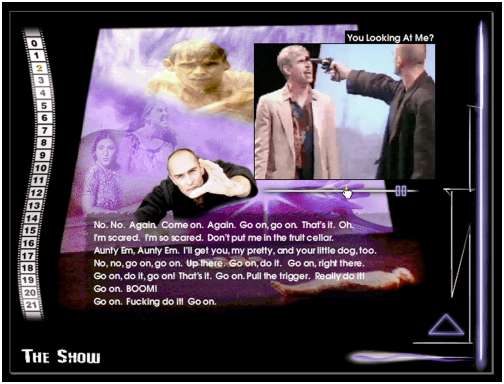
Fig. 1. A collage from the Metabody CD-ROM (© Merlin/Zebington)
| Computers & Texts No.
16/17 |
Table
of Contents |
Winter 1998 |
Barry Smith
Live Art Archive
Nottingham Trent University
barry.smith@btinternet.com
The speedy advance of technology has a way of disadvantaging even its keenest adherents. Before viewing (or even reviewing) Metabody: from Cyborg to Symborg (an interactive encylopaedic documentation of the work of the Australian performance artist Stelarc) you will need to own, beg, borrow or steal a Power Mac 8500 or better with a minimum of 32mb RAM. As advertisements for newer, faster technology begin to shout from every back page in the commercial run-up to the Christmas 1998 Family Market - '400Mhz accompanied by SDRAM expandable up to an incredible 768Mb' - such technical requirements may begin to sound like small beer but when the Metabody CD was first produced (1996, released 1997) it was in the top range; and only produced for Mac. Having neither a Mac nor my Christmas present to hand, in the end I took the middle two of the four options but in reverse order: borrowing a 9600/200 Mac and - conscious that the ReadMe notes strongly recommended full hard-drive installation - begging the owner to find me 70MB of space on his precious and packed hard-disc to install the CD-ROM. All necessary negotiations completed it came as something of a relief to click the Start button even if the hard stare of an anxious owner was disconcerting. But the effort was amply rewarded and for several moments we both just gawped. Even after over a year's development of this image-manipulation technology the resulting opening sequence remained stunning: amoeba-type images gorging their way through abstractions of veined tissue accompanied by passing waveforms, humanoid machines, transmutations, a heavy rhythmic heartbeat soundtrack with a lot of bass and 'emotional presence'... Even the cursor transmuted and pulsated. For long seconds the CD-ROM promised to deliver what the hype had claimed -- 'how electronic systems can extend performance parameters'. Were we on the brink of total cyborg (or is it symborg?) fulfillment? For moments we even felt we were close to understanding the description on the designer's Web site, 'But this is not a static or totalising map or model, it is a paradoxical and animated representation of living-in-the-world'. And for even longer moments I thought, 'Roll on Christmas'. But then, inevitably, that high optimism faded as the links were investigated by 'intuitive navigation' (which meant in practice searching and finding by delving in the bloody tissue and tubes and guessing where links might lead). A little into this process and colleague began muttering about making sacrifices which, given the predominant screen images, seemed all too appropriate.
 |
|
Fig. 1. A collage from the Metabody CD-ROM (© Merlin/Zebington) |
Metabody: from Cyborg to Symborg is a hybrid: a self-contained CD- ROM and an elaborate series of Internet links to sites about Stelarc's work. Stelarc's work physically explores the relationship between the human body and technology -- which means in practice that he swallows surgical cameras (and self-extending sculptures) without the more usual medical imperative, develops prosthetics without needing to replace missing limbs but as additional ones, links himself physically to the electronic impulses of the Internet to see what happens -- and all the while claiming that the human body is obsolete and must prepare itself for technological penetration and advancement. It is an extreme and fascinating viewpoint expressed and explored by the artist at considerable personal physical risk. The CD-ROM attempts to reflect this exploration in its extraordinary graphical excesses but doesn't attempt to explain it, leaving all explanations of this perspective to Stelarc himself by simply linking to various 'official' sites of the artist (there are now several unofficial ones not accessible here, 'Long Live the Internet!'), statements, images, sketch-pad drawings and diagrams. It is therefore a little disappointing, particularly given the promise of the start, in its failure to use the same advanced technology at least to interrogate what is being suggested or to participate in anything approaching a dialectic. Rather it opts to remain with the encyclopedic series of links and hypertext connections which effectively mirror (both metaphorically and in practice) the subject matter of its enquiry, embalming rather than dissecting. Thus, while the options offered are literally worldwide via the Internet - that is to say there are links to Internet (ex BBC) videos, earlier performance milestones such as Ping Body, textual and literary references, biographical details of the artist -- given the title of the CD-ROM (whatever it quite means) it's disappointing that all the material offered seems to stay within the already available and 'factual' - however unusual or unlikely you may consider the starting point to be - and never strays into uncharted futuristic, theoretical or critical territory.
Depending on your Internet connection the Internet links will be faster and more satisfactory or slower and more annoying -- no surprises there, waiting for 'the download' is as commonplace, tiresome and unfortunately as meekly accepted as the queues at the supermarket checkout. Inevitably, however good the connection, the video clips take time (i.e. minutes) to download during which interregnum the larger part of the initial excitement dissipates and the experience of 'living-in-the-world' becomes the more usual experience of highs and lows. During one of the lows you wonder if video streaming and/or DVD might not be the Nirvana which all self-respecting Metabodies should now seek to keep the viewer in the state of Constant Gawp. And it is during one such interruption that reality breaks through and you realise that the overriding rationale for this CD-ROM is overcoming these bandwidth limitations and demonstrating what might be possible in the brave new world of cyborgs and symborgs.
The view that bandwidth is considered crucial and a key motivation in creating this CD-ROM is further substantiated by a comment on the designer's Web site about the CD-ROM which gives the same range of links to Stelarc sites but adds, with a noticeably less mystical tone than when describing its purpose, 'however for the full bandwidth production, get the CD-ROM'. And by the looks of it, based on this evidence, the brave new world is going to be mainly graphics! The literary reference section in particular is cursory with a list of sci-fi references which, at least as far as this CD-ROM is concerned, apparently represent a cul-de-sac. Few literary or theoretical links are made available and the exploration - which could have added an interesting dimension to the study of these developments in performance art in the late 1990s - just stops. Given that most of the biographical sections and all of the official site sections are available on the Net anyway the CD-ROM runs the risk of being familiar territory to Stelarc aficionados (e.g. see http://www.stelarc.va.com.au/pingbody/viu/index.html) though the less familiar could be grateful for the selected guide.
Ping Body -- which features significantly in the CD-ROM -- is one such example. The original performance piece was created over two years ago now (April 1996) and the CD-ROM itself was first published over a year ago (1997). Whilst such terms as 'electrifying', 'powerful' and 'exemplary' in the wholly positive original reviews may have seemed appropriate then, 30 months on the spatial relationship between avatars and the world they inhabit seems to have grown wider not closer and the cyborg concept seems likely to move not simply to 'symborg' (as suggested in the title) but more to symbioses and possibly even to symbolics (the study of creeds). Time will tell!
Hoping to record an easy developmental link between the two CD-ROMS, I asked Steve Dixon - writer and director of a soon-to-be released CD-ROM Chameleons 2 -- if he had seen the Metabody CD-ROM. Unfortunately he ruined my link by answering 'No!'. But developmental link there is nevertheless and if it isn't in the direct advancement of one group's research developments from an earlier prototype then it is in the developments which have occurred both in technology and critical thinking about the use of the technology as a medium for performance documentation and critical exposition. Chameleons 2 is itself a development from a prototype CD-ROM Chameleons ('Chameleons' incidentally is the name of the performance company directed by the author) which, like Metabody was also first developed only in a Mac format; significantly Chameleons 2 is to be made available for Windows and Mac. Even two years metaphorically and literally 'down the line' Chameleons 2 doesn't attempt the extraordinary graphics of Metabody, but as a working document giving the fullest exploration of every conceivable documentary angle it far surpasses it in the critical and explanatory potential it has glimpsed and begins to explore. It therefore reserves its disk-space for what it considers the essentials of the discourse: the full 'show' in 21 continuous or separately selectable scenes (see fig 2), the full text of the dialogue (sometimes more necessary than optional as the stage-play sound is sometimes indistinct), a user-friendly guide to what's available and suggested navigation routes and options to follow myriad threads of documentation. By this means I found myself increasingly engrossed in what was on offer and, with no loading times to distract attention or leave me pondering the mysteries of life and the Internet, increasingly impressed by the simple structure that offers to yield everything and threatens even more. So there's 'the show' but also the context of the show, there's the narrative (inevitably multi-dimensional) and views on and interpretations of the narrative; there's the settings (which used significant chunks of video back-projection all separately available) but also sections on the origins of the video imagery which in turns spins off (if you so choose) into explanations and theoretical references; there are the play's characters and the de-vising process but also each performer's views on what they thought they were being asked to do or were doing at key points; there's an ever-widening investigation of interpretation and semiotics, audience reception and theories of the spectator, of multi-media presentation and possible future developments.
 |
|
Fig. 2. A scene from 'the show' on Chameleons 2 |
Although this CD-ROM claims to be aimed at a wide audience it both stems from and will appeal mostly to a Higher Education clientele. They could certainly do worse than note the simple structure it embraces and enhances, one that I imagine will be replicated many times in the near future as the necessary technology simplifies and expands. It would be churlish to suggest at this early juncture of CD-ROM/DVD development that if every performance of every future show/drama/event/performance were to be given this treatment but in even greater depth via DVD (equivalent to 14 CD-ROMs) -- not to mention all those events of the past that might merit revivalist treatments - that we might end up a mite burdened by information and research documentation. Heresy! We're learning to deal with overload on the Net and we can doubtless develop similar strategies to deal with CD-ROMS and DVD, build into our Time Management Strategies a mere multitude of 30 hour DVDs exploring every nuance of everything and cope. No problem! Or become less obsessed with documenting and archiving every nuance of the now as some neurotic 'stop the world I wanna get off' response to the Millennium Bug? One of these is going to be necessary, I suggest, or graphics really will inherit the earth.
[Table of Contents] [Letter to the Editor]
Computers & Texts 16/17 (1998). Not to be republished in any
form without the author's permission.
HTML Author:
Michael Fraser
Document Created: 22 December 1998
Document
Modified: 11 April 1999
The URL of this document is
http://info.ox.ac.uk/ctitext/publish/comtxt/ct16-17/smith.html